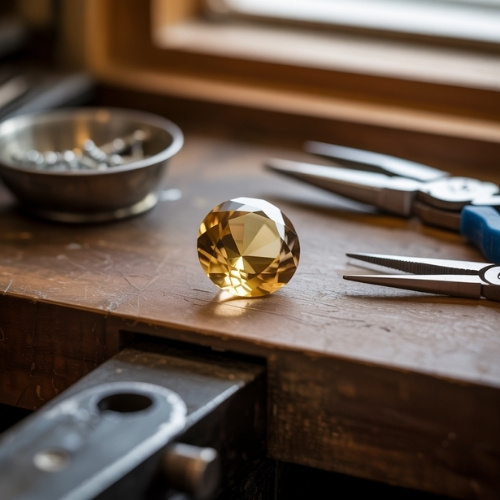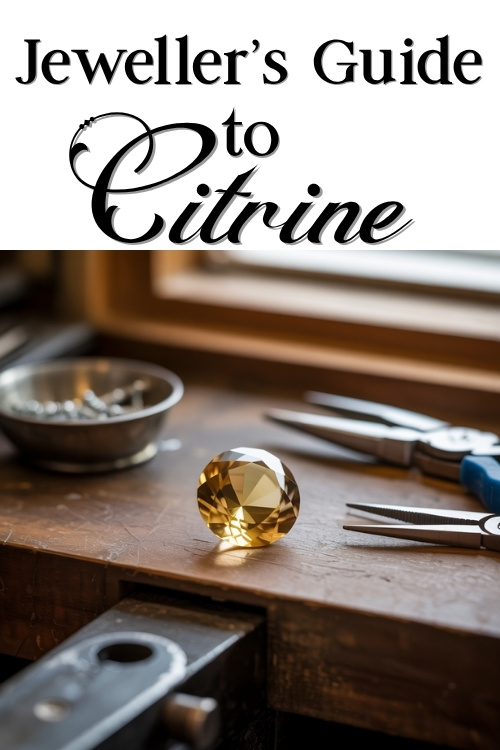Estimated reading time: 4 minutes
Citrine glows with the golden warmth of late afternoon sun. From soft lemon to rich amber, this quartz variety brings joy, vibrancy, and an affordable sparkle to your gem stash. Its inviting hue and natural durability have kept it in steady demand, making it a reliable and radiant choice for jewellers.
Jump to:
Basic Identification Information
Name & Synonyms
Citrine (sometimes referred to as golden quartz)
Species
Quartz
Colour Range
Pale yellow to deep orange-brown
Saturated orange hues with a red tint are often sold as Mandarine citrine.
Refractive Index
1.544 – 1.553
Birefringence
0.009
Optical Sign
Uniaxial +
Pleochroism
Very weak to none
When viable it will show 2 colours, in yellow or orange tones.
Specific Gravity
2.650 to 2.655
Fluorescence
None
Lustre
Vitreous – When polished it has a glass-like finish
Clarity
Type I
Usually eye-clean
Gems Often Mistaken For
Topaz, yellow sapphire, and heliodor (golden beryl)
Mohs Hardness
7
Wearability
Good — durable enough for everyday wear in most jewellery types.
Birthstone
November (shared with topaz)
Spotting Synthetic (Lab-Grown) Citrine
Lab-grown citrine is not common on the market, but synthetic quartz is produced and may be misrepresented.
Inclusions can be a clue. Natural citrine may show fine needles or fluid inclusions under magnification, while synthetic material tends to be flawless or contain nailhead or breadcrumb inclusions.
Placing the gem under a polariscope can also help determine if it’s synthetic or natural as synthetic quartz doesn’t tend to show Brazil law twinning.
Common Treatments
Most citrine sold today has been heat-treated to enhance or change its colour. Pale amethyst or smoky quartz is typically heated to produce yellow to orange shades. This treatment is stable, permanent, and widely accepted in the trade.
Untreated, naturally coloured citrine is significantly rarer and usually paler.
Durability & Setting Considerations
Citrine’s hardness of 7 and lack of cleavage make it a dependable gemstone for any type of jewellery. It stands up well to everyday wear but may show abrasion over time if exposed to harder materials or abrasive conditions.
For jewellery worn daily, especially rings or bracelets, consider settings that protect the stone’s table and facet edges.
Be mindful during repairs or resizing: prolonged exposure to high heat or chemicals can impact citrines appearance, so avoid hot work near set stones where possible.
🛍️ Explore our selection of pre-owned Citrine Gemstones for your next jewellery creation.
Care Instructions
Cleaning
Warm soapy water and a soft toothbrush are safe and effective for cleaning citrine. Most unfilled stones can handle ultrasonic cleaners, but avoid steam cleaning, particularly if treatment status is unknown, as the heat can be damaging.
Storage
Store citrine separately from harder gemstones like sapphire or spinel to avoid scratches. Soft pouches or divided compartments are ideal.
Daily Wear
Citrine holds up well with regular use but benefits from occasional rest. Encourage clients to remove it during heavy manual work and clean it gently to maintain brilliance.
Market & Ethical Notes
The majority of commercial citrine originates from Brazil, particularly Minas Gerais and Rio Grande do Sul. These stones are usually heat-treated amethyst or smoky quartz.
Natural, untreated citrine is uncommon, with small-scale sources in Bolivia, Madagascar, and Russia. These natural stones tend to have a lighter, less saturated colour.
Citrine is generally considered a low-risk gem in terms of ethical sourcing, especially when purchased through reputable suppliers. Still, transparency around treatment and origin should always be part of the conversation, particularly for jewellers focused on traceable or sustainable sourcing.
🔗 Learn more about the ethical and environmental story behind Reclaimed and Recycled Gemstones.
Symbolic & Spiritual Meanings
With its sunny glow and gentle energy, citrine has long been linked to joy, abundance, and vitality. Today, it’s widely used in crystal healing as a stone of positivity, personal power, and financial success.
It’s often associated with the solar plexus chakra, believed to boost motivation, self-confidence, and clarity of purpose.
🔗 Dive deeper into Citrine’s Symbolic & Spiritual Meanings
Etymology
The name “citrine” stems from the French word citron, meaning lemon, an apt reflection of its bright, yellow colour. Though the term became standard in gemology in the 18th century, the stone itself was used centuries earlier under broader names like “yellow quartz.”
🔗Curious about how citrine was viewed in ancient cultures? Explore its fascinating myths and legends
📌 Save this jeweller’s guide to citrine for quick reference next time you’re working with this stunning gem.


